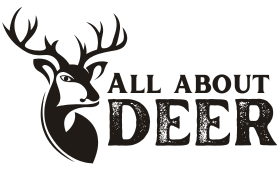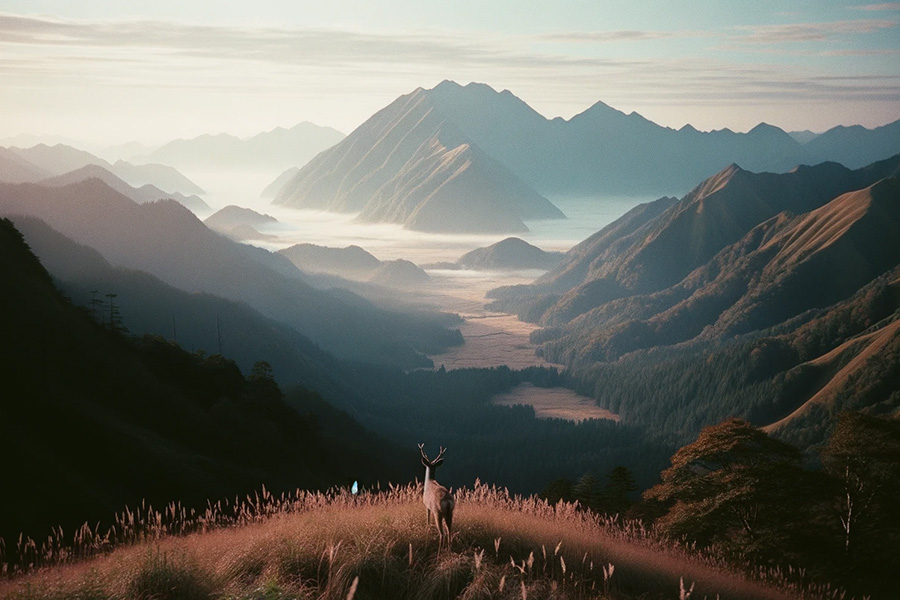What are Deer?
Deer, members of the Cervidae family, are elegant, hoofed mammals recognized for their grace and agility. They inhabit a diverse range of environments, from the icy terrains of the Arctic tundra to the balmy savannas of Africa. Most notably, many male deer species sport a set of antlers, a unique and distinguishing feature.
Why are Deer Important?
Deer aren’t just beautiful creatures to admire; they hold significant roles in their respective ecosystems. As primary prey for many predators, they are pivotal in maintaining ecological balance. Their grazing and browsing habits aid in seed dispersal, fostering plant growth and diversification.
Furthermore, many human cultures hold deer in high regard, attributing them with symbolic meanings like purity and gentleness. Economic benefits also spring from deer, especially in regions where hunting or deer-watching activities draw tourists and enthusiasts.
Table of Contents
Deer Physical Characteristics
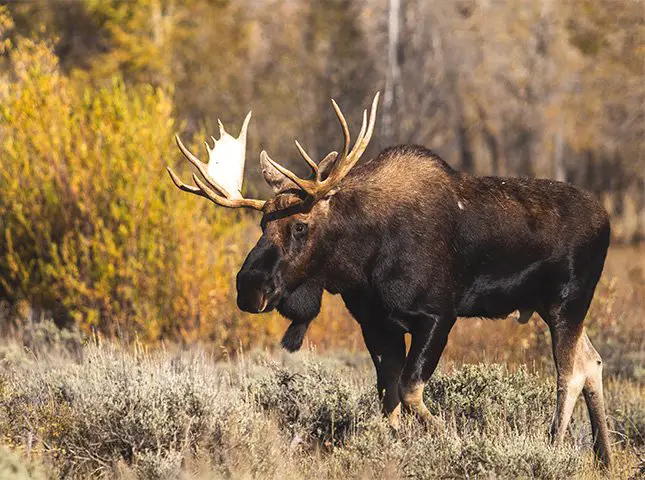
Size and Weight
The world of deer is vast and varied. Ranging in size, the petite pudu from South America stands just over a foot tall, weighing a mere 20 pounds, making it the smallest deer species. On the opposite end of the spectrum, the imposing moose towers at over 6 feet at the shoulder and can tip the scales at an impressive 1,500 pounds, earning its title as the largest deer species.
Antlers: Their Purpose and Growth Cycle
Antlers are not just ornamental; they serve a significant purpose in the deer community. These bony protrusions, primarily found on males, are distinct from horns as they shed and regrow annually. As mating season approaches, males frequently use their antlers to spar with rivals, asserting dominance and vying for the attention of females. Beyond combat, antlers act as indicators of a deer’s health, age, and vitality.
Fur and Colors: The Ever-Changing Coat
A deer’s coat, or pelage, is a marvel of adaptation. Depending on the species and its habitat, deer can sport a range of colors and patterns. The white-tailed deer, for instance, boasts a reddish-brown coat during the warmer months, transitioning to a greyish hue as winter sets in. Others, like the chital, carry distinctive spots, providing camouflage amidst their forested homes.
Eyesight: How Deer See the World
Deer possess large, captivating eyes set on either side of their head, granting them an expansive field of vision. This arrangement is crucial for detecting predators lurking in their periphery. While their nocturnal vision is superior due to an abundance of rod cells, their color perception differs from humans. Current understanding suggests that deer perceive blues and greens but might lack sensitivity to red hues.
Sound and Hearing: The Alertness of Deer Ears
To complement their keen eyesight, deer are equipped with highly attuned ears. These auditory organs can rotate, capturing sounds from various angles. Such acute hearing is indispensable for recognizing approaching threats or subtle movements in their surroundings. Observers might notice a deer’s ears constantly in motion, swiveling and twitching, always on guard and attuned to the sounds of nature.
Deer Habitat and Distribution
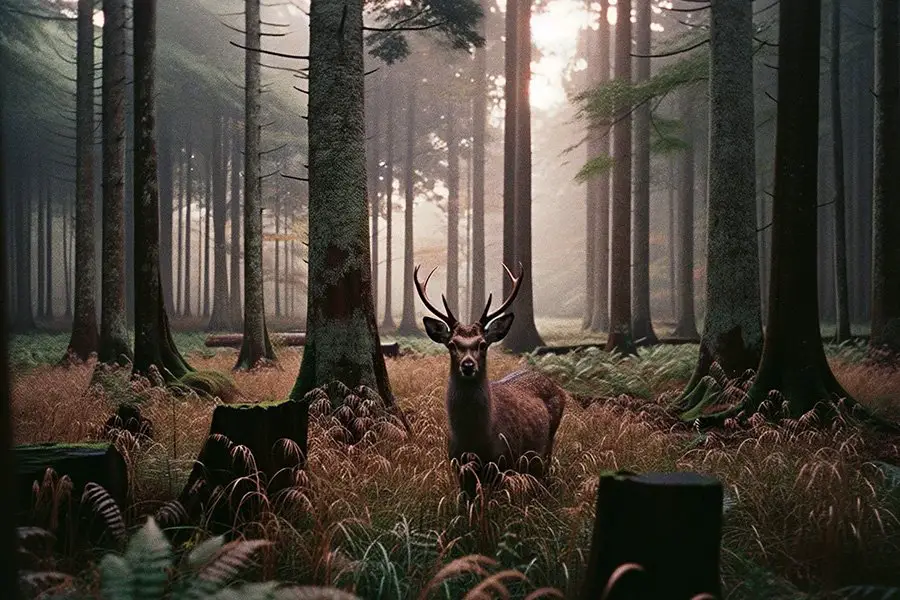
Forest Deer vs. Grassland Deer
Deer are adaptable creatures, thriving in diverse habitats. Forest deer, such as the white-tailed deer and mule deer, prefer wooded areas where trees provide cover from predators and a rich supply of leaves and shrubs to eat. Their coats, often dappled or darker, help them blend into the shadows of the trees.
On the other hand, grassland deer, like the red deer, typically inhabit open plains and meadows. These deer are often larger in size, with a lighter, more uniform coat that matches the golden and green hues of the grasses they graze on.
Deer Around the World: A Look at Continents
Deer are not limited to one corner of the globe; they can be found across multiple continents. North America is home to species like the white-tailed deer and elk. Asia boasts a variety, from the spotted chital to the Siberian roe deer. Europe’s landscapes are graced by the red deer and fallow deer, while South America’s forests are the realm of the tiny pudu and marsh deer.
Adaptations to Different Climates
Deer are remarkable in their ability to adapt to various climates. In the frigid regions of the Arctic, the reindeer have thick, insulated fur and broad hooves to navigate snowy terrains. In contrast, the desert-dwelling Persian gazelle, a type of deer, has lean bodies and long legs to dissipate heat and swiftly cover vast, arid landscapes in search of food and water.
Deer Diet and Eating Habits
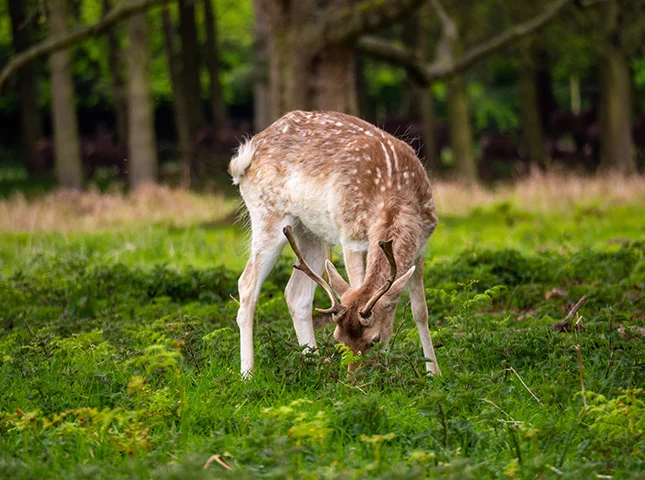
What Do Deer Eat?
Deer are primarily herbivores, though their specific diet can vary based on their habitat. Most deer feed on a mixture of grasses, leaves, twigs, fruits, and nuts. Some species, such as the mule deer, have a penchant for certain plants and will seasonally migrate to areas abundant in their preferred food.
How Deer Find Their Food
Deer rely on their keen senses to locate food. Their sharp eyesight helps them spot fresh growth, while their sensitive noses can detect the scent of ripe fruits or fresh shoots. In regions with seasonal changes, deer have learned to identify and remember locations that yield abundant food sources during different times of the year.
Times When Deer Eat: Dawn and Dusk
Deer are crepuscular animals, which means they are most active during the twilight hours of dawn and dusk. These times offer the safety of low light, protecting them from predators as they forage. It’s not uncommon to spot a deer grazing in the early morning mist or during the soft glow of the evening sun.
Drinking Habits and Water Needs
Water is essential for deer, and they typically drink at least once a day. They prefer calm, fresh water sources like streams, ponds, or lakes. In arid regions, where water is scarce, deer have adapted to extract moisture from the plants they consume, reducing their dependence on direct water sources.
Deer Behavior and Lifestyle
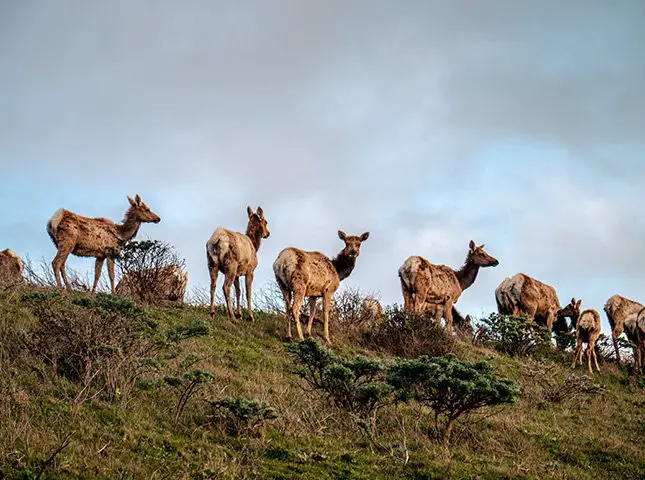
Deer Groups and Herds
While some deer prefer solitude, many species are social animals that form groups. These groups, often called herds, can range from small family units to vast gatherings, especially during migration. Herds provide safety in numbers, helping deer detect predators and defend against them. Within these groups, there’s often a hierarchical structure, with dominant males and females leading the herd.
Mating and Courtship Rituals
The mating season, or rut, is a significant time in the deer calendar. Males often engage in displays of strength, from loud vocalizations to clashing antlers with rivals, all to attract and win over females. Some species, like the red deer, have males that establish territories, which they defend fiercely, hoping to attract females to their domain.
Raising Fawns: The First Steps of Baby Deer
The birth of fawns is a tender moment in the deer life cycle. Mothers usually find a secluded spot to give birth, ensuring the safety of their vulnerable young. For the first few days, fawns remain hidden, with their spotted coats providing camouflage against the forest floor. As they grow, they begin to venture out, staying close to their mothers, who teach them the ways of the forest.
Communication: How Deer “Talk” to Each Other
Deer have a rich vocabulary of sounds and signals. From soft grunts and bleats to communicate within a group, to loud alarm calls warning of danger, their vocalizations play a crucial role in their social structure. Additionally, body language, such as the position of ears or tail flicks, conveys messages among herd members.
Deer Predators and Survival
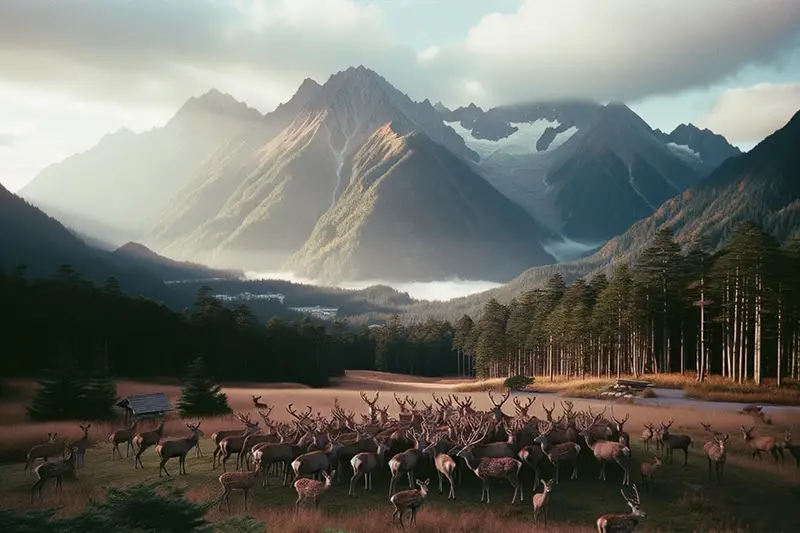
Common Predators of Deer
The beauty and grace of deer do not exempt them from the circle of life. They are preyed upon by various predators. In North America, common predators include wolves, coyotes, and mountain lions. In other parts of the world, tigers, leopards, and even large birds of prey pose a threat to smaller deer species.
How Deer Protect Themselves
Deer have evolved several defense mechanisms. Their keen senses of hearing and smell alert them to approaching danger long before a predator is close. Once alerted, their powerful legs can propel them to swift speeds, allowing them to outrun many threats. In situations where flight isn’t an option, some deer, especially males with antlers, might choose to stand their ground, using their antlers or hooves to fend off attackers.
The Art of Camouflage and Hiding
Nature has gifted deer with the art of disguise. Their coats, whether spotted, dappled, or uniformly colored, help them blend into their surroundings. Fawns, with their speckled fur, can lie motionless in tall grass or foliage, becoming almost invisible. This natural camouflage is their first line of defense against predators, often allowing them to remain undetected.
Deer and Humans
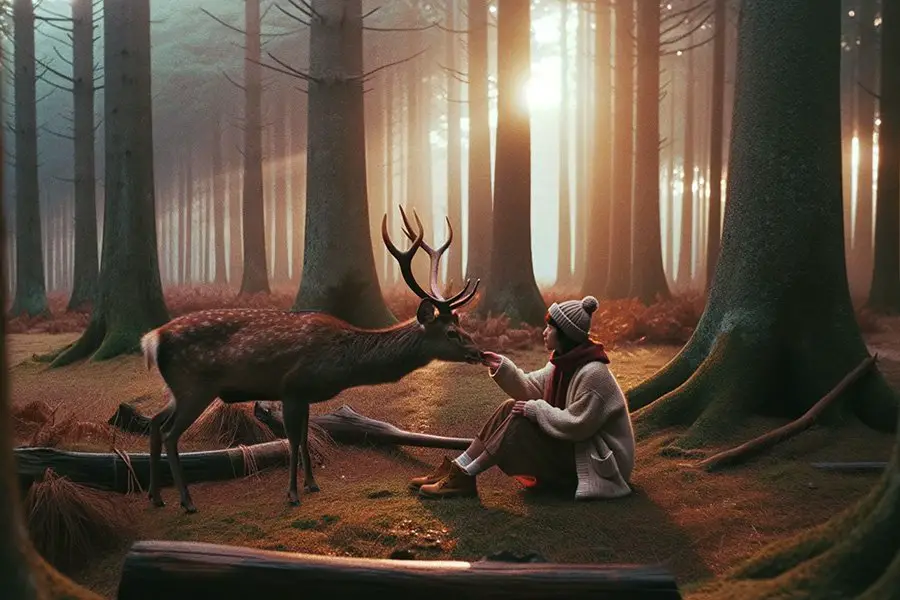
Deer in Folklore and Myths
Throughout history, deer have held a special place in the stories and legends of various cultures. In many Native American tales, deer are symbols of gentleness and are often revered as messengers or guides. European folklore frequently portrays them as majestic creatures, often associated with woodland spirits or deities. In Asian cultures, deer are sometimes seen as symbols of longevity and prosperity. These tales and myths highlight the deep connection and fascination humans have always had with these graceful creatures.
The Role of Deer in Ecosystems
Deer play a pivotal role in maintaining ecological balance. As herbivores, they help control vegetation, ensuring that no single plant species dominates an area. This, in turn, affects the variety of other animals and plants that can thrive in that habitat. Moreover, by serving as prey for various predators, deer are instrumental in supporting the health and balance of predator populations.
Deer and Farming: Conflicts and Coexistence
As human populations grow and expand into traditional deer habitats, conflicts can arise. Deer, attracted to the crops, can cause significant damage to farmlands, leading to economic losses for farmers. However, there are sustainable solutions. Installing deer-resistant fencing, using deterrents, and cultivating deer-resistant crops are some ways farmers coexist with deer, minimizing conflicts while respecting the wildlife.
Conservation and Threats
Why Are Some Deer Species Endangered?
While many deer species have healthy populations, others face the threat of extinction. Habitat loss due to urbanization, deforestation, and agriculture is a primary concern. Additionally, illegal hunting and poaching for meat, antlers, or fur have led to the decline of certain deer populations. Climate change, bringing about shifts in habitat conditions and food availability, further exacerbates the challenges deer face.
Efforts to Protect Deer
Conservationists and wildlife organizations worldwide are working tirelessly to protect and conserve deer. Initiatives include establishing wildlife reserves and parks, implementing anti-poaching measures, and running breeding programs for critically endangered species. Education and awareness campaigns are also crucial, informing the public about the importance of deer and the threats they face.
How We Can Help: Tips for Living with Deer
Living harmoniously with deer requires understanding and respect. Here are some tips:
- Drive Carefully: Especially during dawn and dusk, when deer are most active.
- Plant Deer-Resistant Gardens: This can deter deer from venturing into residential areas in search of food.
- Use Natural Deterrents: Such as sprays or motion-activated sprinklers, to keep deer at bay without causing them harm.
- Support Conservation Efforts: Donate or volunteer with organizations dedicated to deer conservation.
Deer Species
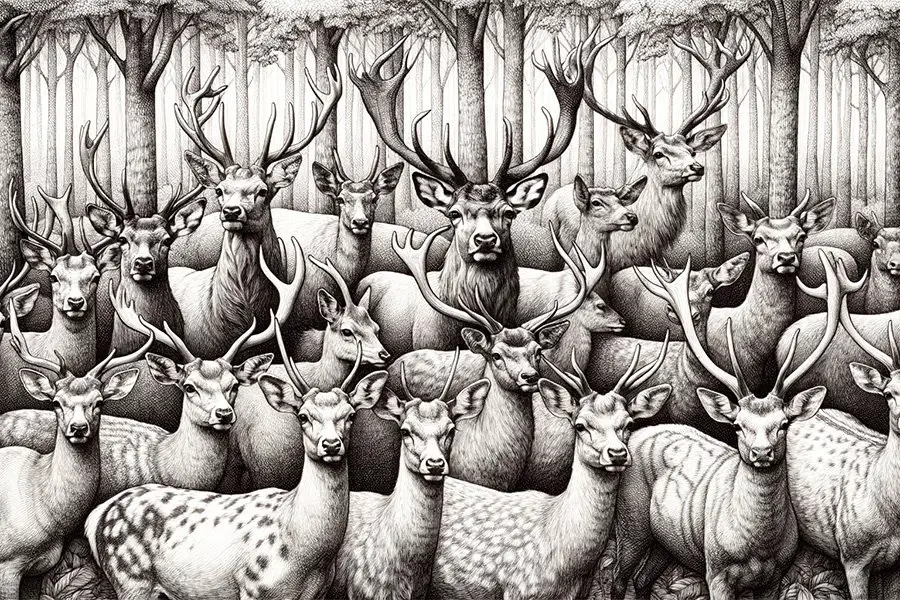
The Majestic Reindeer of the North
- Scientific Name: Rangifer tarandus
- Habitat: Arctic, sub-Arctic, and mountainous regions of northern Europe, Siberia, and North America.
- Description: The reindeer, known as caribou in North America, stands as a testament to nature’s ability to adapt and thrive in extreme conditions. Boasting a thick coat comprised of dense underfur and longer, hollow overhairs, they are insulated against the harsh Arctic temperatures.
Their large, flat hooves serve dual purposes: distributing weight over snowy surfaces, preventing them from sinking, and acting as efficient paddles when swimming. Unique among deer, both male and female reindeer grow antlers. Their annual shedding and regrowth are a fascinating natural phenomenon, driven by complex hormonal changes. Reindeer have a special role in human culture, especially among indigenous Arctic communities.
For generations, they have served as essential beasts of burden, providers of meat and fur, and spiritual symbols. The annual migration of some reindeer populations, covering vast distances in search of food, stands as one of nature’s most awe-inspiring events.
The Tiny Muntjac: Smallest of the Deer
- Scientific Name: Muntiacus
- Habitat: Forests of South and Southeast Asia.
- Description: The muntjac, with its petite stature, holds a unique place in the deer family. Commonly referred to as “barking deer” due to their dog-like calls, muntjacs have a distinctive appearance.
They possess short but sturdy antlers and elongated canine teeth, which they use during territorial disputes. Their reddish-brown fur provides camouflage within the dense forests they call home. Muntjacs are solitary by nature, marking their territory with secretions from their preorbital glands.
Their diet is varied, consisting of grass, fruits, seeds, and even small animals, showcasing their adaptability. Their keen senses, especially their hearing, keep them alert to potential dangers in their environment.
White-tailed Deer: America’s Favorite
- Scientific Name: Odocoileus virginianus
- Habitat: Diverse environments across North America, from forests and grasslands to suburban areas.
- Description: The white-tailed deer, characterized by the white underside of its tail, stands as one of the most iconic wildlife species of North America. Their agile bodies, topped with a reddish-brown summer coat that transitions to grey-brown in the winter, are built for speed and agility.
When sensing danger, they raise their distinctive tail as a warning sign to other deer. Primarily herbivores, their diet includes grass, legumes, and the shoots, leaves, and bark of trees. The mating ritual, known as the rut, sees males engage in fierce battles, locking their antlers in displays of strength to win over females.
Their adaptability to various habitats, from dense woods to open plains and even urban areas, speaks volumes about their resilience and evolutionary success.
Red Deer: Europe’s Large Deer
- Scientific Name: Cervus elaphus
- Habitat: Forests, moorlands, and grasslands of Europe, parts of Asia, and North Africa.
- Description: The red deer, with its majestic stature, is one of the largest deer species and is widely distributed across Europe. Recognized for its robust build and a coat that varies from reddish-brown to grey, this deer showcases white spots on its back and flanks during summer months.
Males, known as stags, boast impressive branched antlers that they shed and regrow annually. The autumnal rutting season sees stags bellowing loudly and engaging in fierce antler clashes to establish dominance and win over hinds (females). Their diet is diverse, ranging from grass and heather to tree leaves and young shoots. Cultural significance surrounds the red deer, with its image often appearing in European cave art and mythology.
Sika Deer: The Spotted Deer of East Asia
- Scientific Name: Cervus nippon
- Habitat: Forests, grasslands, and marshes of East Asia.
- Description: The sika deer, also known as the spotted deer, is native to East Asia and is celebrated for its beautiful coat marked with white spots. These deer display a summer coat that is reddish or brownish with spots, transitioning to a darker, thicker coat in winter. Males possess a set of upright antlers with a distinctive V-shape.
Sika deer are vocal animals, with a range of calls used for communication, especially during the rutting season. While they primarily graze on grass, they also browse on leaves, stems, and even seaweed in coastal areas. Due to their adaptability, sika deer populations have been introduced to various parts of the world.
Roe Deer: The Agile Deer of Europe and Asia
- Scientific Name: Capreolus capreolus
- Habitat: Woodlands, grasslands, and agricultural areas across Europe and parts of Asia.
- Description: The roe deer is a petite yet agile species known for its elegance and swift movements. They have a reddish or greyish-brown coat, with a characteristic white rump patch. Males, referred to as roebucks, have short, straight antlers with three tines. Roe deer are solitary creatures, with territories marked by scent glands.
Their diet consists of grass, herbs, leaves, and shoots. During summer, they are crepuscular, being most active during dawn and dusk, while winter sees them more active during daylight. Their sharp senses and swift reflexes make them adept at evading predators.
Fallow Deer: Known for Their Palmate Antlers
- Scientific Name: Dama dama
- Habitat: Woodlands and open grasslands across Europe.
- Description: The fallow deer is easily distinguishable by its broad, palmate (flattened) antlers, unique among deer species. Their coat can vary from reddish-brown with white spots in summer to a thicker, unspotted grey coat in winter. A notable variant is the black fallow deer, which lacks the characteristic spots.
They are social animals, often seen grazing in groups. Their diet includes grass, herbs, and young woody plants. Historically, they were prized ornamental species and were introduced to various parts of the world by nobility.
Sambar Deer: Asia’s Largest Deer Species
- Scientific Name: Rusa unicolor
- Habitat: Dense forests of the Indian subcontinent and Southeast Asia.
- Description: The sambar deer stands as the largest deer species in Asia. With a dark brown coat and sturdy build, they are truly a sight to behold. Males possess rugged, branching antlers. Being primarily nocturnal, sambar deer are elusive and prefer dense forest habitats near water sources.
They are versatile eaters, consuming a variety of vegetation, from leaves and grass to fruit and water plants. They play a significant role in their ecosystems, serving as primary prey for apex predators like tigers.
Barasingha: The Swamp Deer of India
- Scientific Name: Rucervus duvaucelii
- Habitat: Swamps and grasslands of India, particularly in the states of Madhya Pradesh and Uttar Pradesh.
- Description: The Barasingha, named for its twelve-tined antlers which means “twelve” in Hindi, is a magnificent species native to India. With a coat that varies from yellowish-brown in summer to darker brown in winter, these deer have long, strong legs suited for their swampy habitats. They are known to form large herds, especially in open grasslands.
Their diet primarily consists of grasses, supplemented with aquatic plants. The Barasingha plays a crucial role in its ecosystem, but has faced threats due to habitat loss, leading to conservation efforts to protect this unique species.
Père David’s Deer: The Milu from China’s Wetlands
- Scientific Name: Elaphurus davidianus
- Habitat: Originally from the river valleys of China, now mostly found in reserves and zoos worldwide.
- Description: Père David’s deer, often called the milu, is an intriguing species with characteristics of several deer types. With backward-pointing antlers, a horse-like tail, and hooves resembling that of a cow, it’s a unique blend of features. Sadly, this deer was extinct in the wild by the early 20th century. However, thanks to conservation efforts and reintroduction programs, they now have a renewed presence in their native habitats. They are primarily grazers, feeding on a mix of grasses and aquatic plants.
Black-tailed Deer: Native to the Pacific Northwest
- Scientific Name: Odocoileus hemionus columbianus
- Habitat: Forests, chaparrals, and grasslands of the Pacific Northwest, from California to British Columbia.
- Description: The black-tailed deer, a subspecies of the mule deer, is characterized by its black-tipped tail. Medium-sized with a greyish-brown coat, these deer are well-adapted to the varied terrains of the Pacific Northwest. Their large ears and alert demeanor make them adept at detecting predators. They feed on a diverse diet, including shrubs, grasses, and berries, with their feeding patterns shifting based on the seasons.
Eld’s Deer: Also Known as the Thamin or Brow-antlered Deer
- Scientific Name: Rucervus eldii
- Habitat: Grasslands and forests of Southeast Asia, especially in Myanmar, Thailand, and Cambodia.
- Description: Eld’s deer, with its impressive three-tined antlers, has a graceful appearance. Its coat varies from light brown to reddish, providing camouflage in its natural habitat. These deer are crepuscular, being most active during dawn and dusk. They primarily graze on grasses but also consume fruits and flowers. Due to habitat loss and hunting, their numbers have declined, making conservation efforts crucial for their survival.
Philippine Spotted Deer: Native to the Visayan Islands
- Scientific Name: Rusa alfredi
- Habitat: Rainforests of the Visayan islands in the Philippines.
- Description: This small, elusive deer is known for its dark brown coat adorned with white spots. With a compact build and agile nature, they navigate the dense forests of the Visayan islands efficiently. They are primarily nocturnal, feeding on leaves, buds, and fruits. The Philippine spotted deer faces threats from habitat destruction and hunting, placing them on the list of endangered species.
Huemul: The South Andean Deer
- Scientific Name: Hippocamelus bisulcus
- Habitat: Forested mountainous regions of southern Chile and Argentina.
- Description: The Huemul, also known as the South Andean deer, boasts a thick, coarse coat that varies from brown to greyish, helping it blend into its mountainous surroundings. With a sturdy build and relatively short legs, the Huemul is well-adapted to the rough terrains of the Andes. They are solitary creatures, often found grazing on shrubs, grasses, and leaves. The Huemul holds significant cultural importance, even being featured on Chile’s national coat of arms. However, habitat loss and poaching have led to a decline in their numbers, making them a conservation priority.
Pampas Deer: Found in the Grasslands of South America
- Scientific Name: Ozotoceros bezoarticus
- Habitat: Pampas grasslands of Brazil, Argentina, Uruguay, and Paraguay.
- Description: The Pampas deer, with its reddish-brown coat and white markings, is a graceful inhabitant of South America’s vast grasslands. They possess slender bodies and long legs, which aid in their swift movements across the open terrains. Their diet consists primarily of grasses, supplemented occasionally by herbs and shrubs. While they are mostly active during the day, in regions with significant human activity, they tend to become more nocturnal to avoid disturbances.
Marsh Deer: The Swamp-loving Deer of South America
- Scientific Name: Blastocerus dichotomus
- Habitat: Wetlands, swamps, and marshes of central and south-eastern South America.
- Description: The Marsh deer, as its name suggests, is adapted to life in wetlands. With long legs and wide hooves, they can easily navigate marshy terrains. Their reddish-brown coat becomes darker and shaggier during the colder months.
They have a preference for aquatic plants, which form a significant portion of their diet. The large ears and alert eyes of the Marsh deer keep them constantly aware of their surroundings, helping them detect predators in the dense reeds and grasses of their habitat.
Brocket Deer: The Small Forest Deer of Central and South America
- Scientific Name: Genus Mazama
- Habitat: Dense forests of Central and South America.
- Description: Brocket deer are small, compact deer known for their short antlers and vibrant reddish or brownish coats. Different species of Brocket deer vary in size and coloration, but all are well-suited to life in dense forests. They are solitary and secretive, often browsing on leaves, fruits, and flowers. Their small stature allows them to move quietly and efficiently through the thick underbrush, making them elusive and often challenging to spot.
Visayan Spotted Deer: An Endangered Species from the Philippines
- Scientific Name: Rusa alfredi
- Habitat: Rainforests of the Visayan islands in the Philippines.
- Description: The Visayan spotted deer, with its dark brown coat adorned with white spots, is a symbol of the rich biodiversity of the Philippines. However, it’s also a poignant reminder of the fragile nature of our ecosystems. They navigate the dense rainforests of the Visayan islands, feeding primarily at night on leaves, shoots, and fruits. Due to extensive habitat loss and hunting pressures, the Visayan spotted deer’s numbers have dwindled, categorizing them as endangered and underscoring the urgent need for conservation efforts.
Peary Caribou: The Smallest Subspecies of Caribou
- Scientific Name: Rangifer tarandus pearyi
- Habitat: Arctic islands of northern Canada.
- Description: The Peary caribou, distinguished as the smallest subspecies of caribou, is uniquely adapted to life in the Arctic’s extreme conditions. Their white winter coats provide both insulation against the cold and camouflage against the snowy landscapes. Come summer, their fur transitions to a light grey or brown.
They primarily graze on lichens, mosses, and Arctic plants. Due to their isolated habitats and the challenges of the Arctic environment, Peary caribou populations can be particularly vulnerable to changes in climate and food availability.
Thorold’s Deer: Found in the Tibetan Plateau
- Scientific Name: Cervus albirostris
- Habitat: Alpine meadows and forested regions of the Tibetan Plateau.
- Description: Thorold’s deer, with its thick and shaggy white fur around the neck and underbelly, is well-equipped for the cold climates of the Tibetan Plateau. Males boast impressive antlers, which they use during the rutting season in displays of dominance. Their diet consists of grasses, herbs, and shrubs found in their high-altitude habitats. Their strong, sturdy legs allow them to navigate the rugged terrains of the Himalayas with ease.
Javan Rusa: Native to the Islands of Java, Bali, and Timor
- Scientific Name: Rusa timorensis
- Habitat: Tropical forests and grassy areas of Java, Bali, and Timor.
- Description: The Javan rusa, with its grey-brown coat and three-tined antlers, thrives in the tropical climates of Indonesia’s islands. They are crepuscular, most active during the early morning and late afternoon. Their diet includes grasses, leaves, and fruits. While they can often be seen grazing in open areas, they seek shelter in forests during the hottest parts of the day.
Indian Hog Deer: Known for its Hog-like Running Style
- Scientific Name: Axis porcinus
- Habitat: Grasslands, swamps, and floodplains of northern India, Nepal, and parts of Southeast Asia.
- Description: The Indian hog deer gets its name from its unique running style, where it darts through underbrush and tall grasses much like a hog. Compact and sturdy, with a yellow-brown coat, this deer often avoids open spaces, preferring the cover of thick vegetation. Instead of jumping over obstacles, they often duck under them, further emphasizing their hog-like behavior. They primarily feed on grasses, herbs, and occasional fruits.
Calamian Deer: Found Only in the Calamian Islands of the Philippines
- Scientific Name: Axis calamianensis
- Habitat: Forested regions of the Calamian Islands in the Philippines.
- Description: The Calamian deer, also known as the Calamian hog deer, is a small and elusive species endemic to the Calamian group of islands. Their brown coat helps camouflage them within their forest habitats. These deer are nocturnal, foraging for leaves, fruits, and grasses under the cover of night. Their isolated habitat has kept them relatively protected, but habitat loss poses a threat to their populations.
Bawean Deer: Endemic to Bawean Island in Indonesia
- Scientific Name: Hyelaphus kuhlii
- Habitat: Forests of Bawean Island in Indonesia.
- Description: The Bawean deer, also known as Kuhl’s hog deer, is a unique species found only on Bawean Island. With a reddish-brown coat and a white underbelly, they are adapted to life in dense forests. Their diet consists mainly of grasses, fruits, and leaves. Due to their limited range and habitat destruction, the Bawean deer faces challenges to its survival, emphasizing the importance of conservation efforts on the island.
Lesser Mouse-deer: One of the Smallest Hoofed Animals
- Scientific Name: Tragulus kanchil
- Habitat: Forests of Southeast Asia, including Malaysia, Thailand, and Indonesia.
- Description: The lesser mouse-deer, despite its name, is not a mouse but one of the world’s tiniest ungulates. With a delicate build, this little creature has a light brown coat adorned with subtle white markings on its chest. It navigates the forest floor with agility, feeding on fallen fruits, leaves, and fungi. Its small size and secretive nature make it a challenge to spot in the dense undergrowth of its tropical habitat.
Greater Mouse-deer: Slightly Larger than its Lesser Counterpart
- Scientific Name: Tragulus napu
- Habitat: Tropical forests and mangroves of Southeast Asia.
- Description: The greater mouse-deer, slightly larger than the lesser mouse-deer, shares many of its relative’s characteristics. With long, slender legs and a reddish-brown coat, they tread softly in their forested environments. Their diet is varied, including leaves, shoots, and fruits. Being crepuscular, they are most active during dawn and dusk, often evading predators with their swift and silent movements.
Kashmir Stag: Also Known as Hangul, Native to India
- Scientific Name: Cervus canadensis hanglu
- Habitat: Dense riverine forests of northern India, particularly in the Kashmir Valley.
- Description: The Kashmir stag, or hangul, is a subspecies of the elk and is known for its impressive antlers and sturdy build. Its reddish-brown coat, with a dense mane around the neck, provides warmth in the chilly forests of Kashmir.
The hangul plays a significant role in the local ecosystem, grazing on grasses, leaves, and shrubs. With decreasing habitats and pressures from poaching, the hangul’s numbers have dwindled, leading to conservation efforts to protect this majestic creature.
Key Deer: The Diminutive Deer of the Florida Keys
- Scientific Name: Odocoileus virginianus clavium
- Habitat: Pine rockland forests, freshwater wetlands, and mangroves of the Florida Keys.
- Description: The Key deer is the smallest subspecies of the North American white-tailed deer. With a height often comparable to a large dog, this deer has adapted to life on the islands of the Florida Keys. They are often spotted grazing on plants and shrubs, with a preference for freshwater sources. Their curious and friendly nature, combined with their isolated habitat, has made them a unique attraction in the region.
Axis Deer: Another Name for the Spotted Chital
- Scientific Name: Axis axis
- Habitat: Forested regions of the Indian subcontinent.
- Description: Also known as the chital or spotted deer, the axis deer is celebrated for its vibrant reddish-brown coat dotted with white spots. They are highly social animals, often forming groups segregated by gender. Their diet primarily consists of grass and vegetation found in forested areas. The forests come alive with their bell-like calls, especially during the mating season.
Yucatan Brown Brocket: Native to the Yucatan Peninsula
- Scientific Name: Mazama pandora
- Habitat: Tropical forests of the Yucatan Peninsula in Mexico.
- Description: The Yucatan brown brocket is a small deer species native to the Yucatan Peninsula. With a compact build and a rich brown coat, this deer is well-suited to the dense tropical forests of its habitat. They are primarily browsers, feeding on leaves, fruits, and flowers. Their elusive nature and preference for thick vegetation mean they remain a less-studied species, adding to the mysteries of the region’s rich biodiversity.
Gray Brocket: Found in South and Central America
- Scientific Name: Mazama gouazoubira
- Habitat: Forests and savannas of South and Central America.
- Description: The gray brocket is a medium-sized deer with a soft grayish-brown coat, giving it its name. It has a compact build with short legs, allowing it to move swiftly through dense forests and undergrowth. Their diet consists mainly of leaves, fruits, and flowers. Being a solitary animal, they are often elusive, navigating their habitats with caution and grace.
Red Brocket: The Largest Brocket Deer from Central and South America
- Scientific Name: Mazama americana
- Habitat: Rainforests and cloud forests of Central and South America.
- Description: The red brocket, the largest among the brocket deer, boasts a stunning reddish-brown coat. With strong and muscular legs, they are well-adapted to rugged terrains. They are primarily browsers, feeding on a diverse range of plant material, from leaves and shoots to fruits. Their solitary nature and preference for dense forests make them a mysterious presence in the tropical jungles.
Northern Pudu: The World’s Smallest Deer Species from South America
- Scientific Name: Pudu mephistophiles
- Habitat: Cloud forests of the Andes in Colombia, Ecuador, and Peru.
- Description: The northern pudu holds the title for being the smallest deer species globally. With a height often not exceeding 35 cm at the shoulder, it’s a tiny wonder of the deer world. Their brown coat provides camouflage in the dense undergrowth of the Andean forests. They primarily feed on leaves, twigs, and fruits. Their small size and timid nature make them vulnerable to predators, requiring them to be constantly vigilant.
Southern Pudu: Slightly Larger than the Northern Pudu but Still Tiny
- Scientific Name: Pudu puda
- Habitat: Temperate rainforests of southern Chile and Argentina.
- Description: The southern pudu, while being slightly larger than its northern counterpart, is still a miniature marvel. Their reddish-brown to dark brown coat helps them blend seamlessly into their forested habitats. These deer are browsers, feeding on leaves, bark, and fruits. Their keen sense of hearing and alertness keep them safe in environments filled with potential threats.
Elk (or Wapiti): One of the Largest Deer Species Native to North America and Eastern Asia
- Scientific Name: Cervus canadensis
- Habitat: Forests, grasslands, and parklands of North America and eastern parts of Asia.
- Description: The elk, also known as wapiti, is among the largest deer species. Recognized by their impressive set of antlers and a thick mane around the neck, male elk are a majestic sight. Their coat varies from a reddish hue in summer to a brownish-gray in winter. They are known for their bugling calls, especially during the rutting season. Elks are grazers, feeding on grasses, but they also browse on shrubs and trees.
Moose (or Eurasian Elk in Europe): The Largest of All Deer Species, Found in Northern North America and Northern Eurasia
- Scientific Name: Alces alces
- Habitat: Boreal forests and temperate broadleaf forests of northern North America and Eurasia.
- Description: The moose, known as the Eurasian elk in Europe, stands as the giant of the deer family. With long legs, a humped nose, and broad, flat antlers, their appearance is distinctive. Their coat is a dark brown, providing insulation against the cold climates they inhabit. Moose are both grazers and browsers, feeding on aquatic vegetation, shrubs, and young tree shoots. Their size and strength make them a formidable presence in their habitats, with few natural predators.
Deer in Popular Culture: Movies, Books, and More
Deer have been a source of inspiration in various forms of art and media throughout history. Their grace, beauty, and symbolic meanings have made them popular characters in tales and legends.
- Movies: One of the most iconic films featuring a deer is Disney’s “Bambi.” Released in 1942, it tells the story of a young fawn named Bambi as he grows up and faces the challenges of the wild. This film has touched many hearts and taught valuable lessons about love, loss, and life.
- Literature: “The White Stag” by Kate Seredy is a Newbery Medal-winning book that tells a fictional account of the migration of the Huns and Magyars. The white stag, a symbol of destiny, plays a pivotal role in this story.
- Folklore and Mythology: In many cultures, deer are symbols of purity and rebirth. They often play significant roles in myths, legends, and fairy tales. For instance, in Celtic legends, the deer is a magical creature, often leading heroes to new discoveries.
- Music: Several musicians and bands have referenced deer in their songs or album artwork, symbolizing various themes from innocence to wilderness.
- Art: From ancient cave paintings to modern digital art, deer have been a favorite subject for many artists. Their elegance and poise make them a popular choice for nature-inspired artwork.
- Television: Series like “Over the Garden Wall” have episodes that depict deer, often giving them mystical or otherworldly qualities.
Comparing Deer to Other Animals
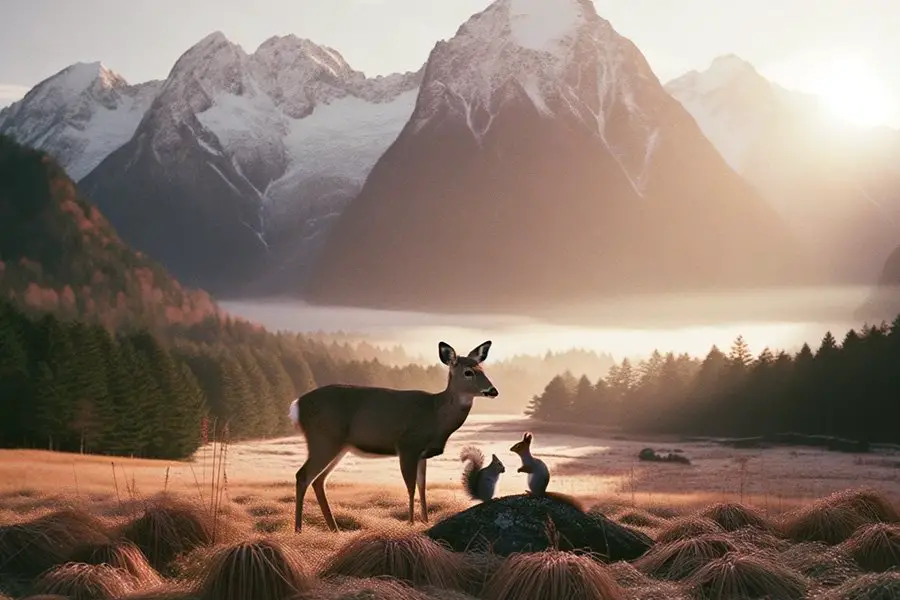
Deer are unique in many ways, but when compared to other animals, certain similarities and differences become evident:
- Physical Characteristics: Unlike bovines (cows) and equines (horses), deer have antlers, which are bone structures that they shed and regrow annually. Only a few other animals, like moose and elk, share this trait.
- Diet: Deer are herbivores, primarily feeding on grass, leaves, and shrubs. This diet is similar to that of many other herbivores, such as cows and sheep. However, unlike goats, which can eat almost any plant, deer are more selective feeders.
- Behavior: Deer, especially species like the white-tailed deer, are known for their skittishness. This cautious behavior is unlike the boldness exhibited by predators like wolves or bears.
- Habitat: Deer are incredibly adaptable and can live in a variety of habitats, from dense forests to open plains. This adaptability is shared with animals like foxes and raccoons.
- Symbolism: In many cultures, deer symbolize gentleness, grace, and peace. This is in contrast to predators like lions or eagles, which often symbolize strength and power.
- Role in Ecosystem: Deer play a vital role in their ecosystem, helping control vegetation growth and serving as prey for various predators. This ecological niche is similar to other herbivores, such as bison or antelope.
Conclusion
The Beauty and Wonder of Deer
Deer, with their graceful movements and gentle demeanor, have always been a symbol of nature’s elegance. Their presence in forests, meadows, and even urban environments serves as a reminder of the delicate balance of our ecosystem. The sight of a deer, whether it’s a lone stag standing majestically against the horizon or a doe tenderly caring for her fawns, evokes a sense of awe and wonder.
Their antlers, which are shed and regrown annually, are a testament to nature’s cycles of growth, loss, and renewal. The soft, dappled fur of fawns, designed to camouflage them against the forest floor, showcases nature’s intricate designs for survival. Every leap, every gaze, every movement of a deer speaks of a world that thrives in harmony and rhythm.
Why Learning About Deer Matters
Understanding deer is not just about appreciating their beauty; it’s about recognizing their role in the larger picture of our environment. Deer are both grazers and prey, maintaining the health of our forests and serving as a food source for predators. Their population dynamics can be an indicator of the health of an ecosystem, making them vital for conservation efforts.
Moreover, as human habitats expand and encroach upon wilderness areas, conflicts between deer and humans become more frequent. By understanding their behavior, habitat needs, and feeding patterns, we can develop strategies to coexist peacefully.
Additionally, deer have cultural, spiritual, and economic significance in many societies around the world. They feature in myths, legends, and art, symbolizing various attributes from purity to rebirth. Economically, deer hunting and deer-watching contribute significantly to local economies in many regions.
In essence, learning about deer is a journey into understanding the delicate balance of nature. It reinforces the idea that every creature, no matter how seemingly insignificant, plays a crucial role in the tapestry of life. By appreciating and protecting deer, we are taking steps toward preserving the beauty and wonder of the world we inhabit.
